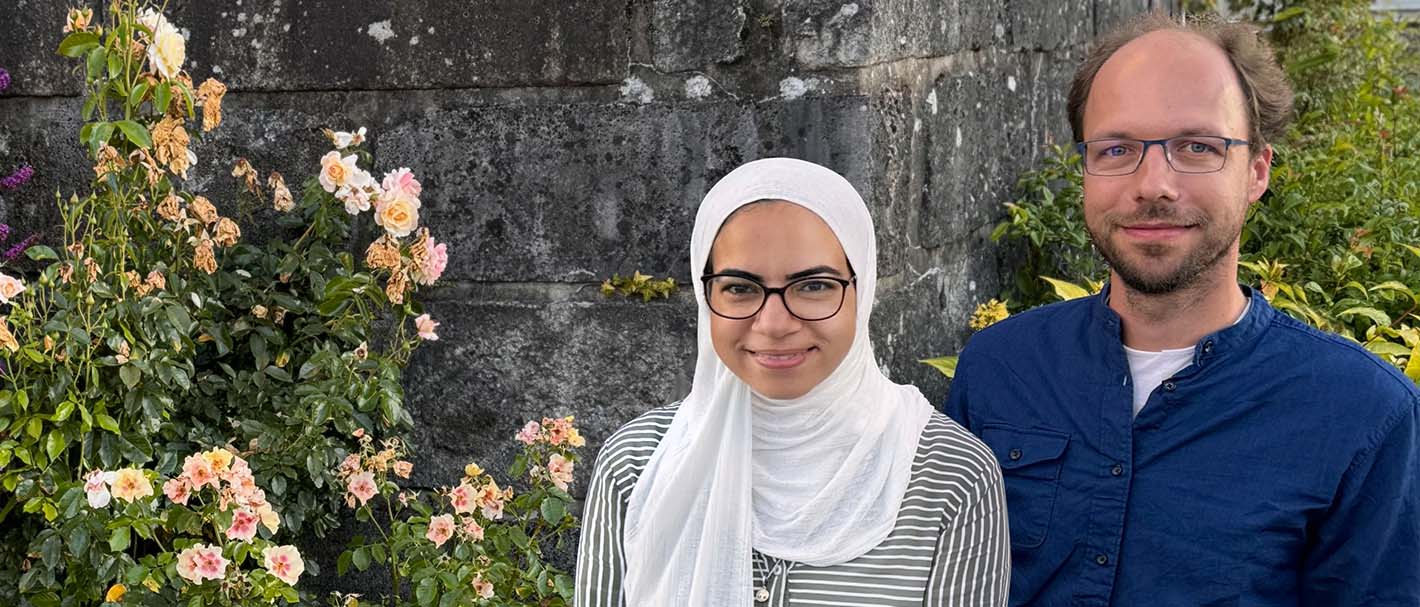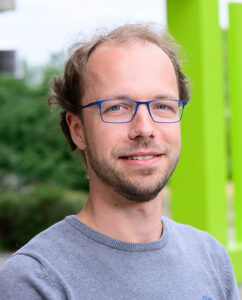25. July 2024 | Interviews
“Institutional hurdles slow the integration of refugees down”

Maye Ehab and Philipp Jaschke have just published an English IAB Brief Report together with Yuliya Kosyakova and Herbert Brücker on the labour market integration of refugees.

Philipp Jaschke is a senior researcher in the department “Migration and International Labour Studies” at the IAB.
You have been analysing the integration of refugees in the German labour market since 2016. How have the employment trends of refugees developed since the survey was first introduced?
Jaschke: We started with the first wave of the IAB-BAMF-SOEP Refugee Survey in 2016. This longitudinal data shows an increase in the employment rates of refugees who arrived between 2013 and 2019 over their length of residency. The refugees’ employment rates were still low in the first year after arrival, at less than 10 per cent. This is due to institutional and individual hurdles, particularly early after their arrival. After six years in Germany, the average employment rate reaches 57 percent, 63 percent after seven years and 68 percent for refugees who have been living in Germany for eight years or more.
Why have the employment rates of female and male migrants developed differently?
Maye Ehab: Although the employment rates of female and male refugees increase over time, there is already a clear gender gap in the first few years of the integration process. After eight or more years in Germany, the employment rate of refugee men is 86 percent which exceeds the average rate of 81 percent for the male population in Germany. In contrast, the employment rate of refugee women, at 33 percent, is well below the average for the female population of 72 percent.
Jaschke: “Improving child-care infrastructure could increase refugee women’s labour market integration.”
What are the key barriers to employment for female refugees?
Jaschke: Women face many obstacles to getting into work. One major hurdle is the burden of care responsibilities: almost three quarters of female refugees have children; one third have children under the age of three, compared to 13 percent of men as a short report by Yuliya Kosyakova and colleagues in 2021 showed. An article by Ludovica Gambaro and her colleagues from 2021 has shown that the provision of early childhood education and care has a strong positive integration effect for mothers ⎼ in particular for language and employment. A tailored childcare infrastructure for families is therefore key to enabling women’s participation ⎼ not only in education but also in the labour market.
What else hinders refugee women from integrating into the labour market?

Dr Maye Ehab is a senior researcher in the department “Migration and International Labour Studies“ at the IAB.
Ehab: In addition, refugee women invest later in language and education in Germany than men and they make less use of employment-related advisory services. Another factor is that, on average, women would have been less likely to be employed in their countries of origin and, those who had been employed in their home countries had jobs in professions whose access is highly regulated in Germany, for example in the education sector. This makes it more difficult for these women to properly utilise their skills and qualifications in the German labour market. Yuliya Kosyakova and colleagues have more details on this published in their 2021-brief report.
Addressing the specific challenges faced by female refugees requires targeted support measures, such as improved childcare infrastructure, and tailored educational and advisory services that suits mothers. By addressing these barriers, we can foster higher gender equality for refugees in the labour market.
Ehab: “The refugees’ sense of being welcomed plays a role in shaping integration trajectories.”
What are the main factors which aid a rapid integration of migrants into the labour market? And are there any differences between men and women?
Jaschke: Shared refugee accommodation such as in reception facilities has a particularly strong negative correlation with labour market integration. An even stronger statistical correlation can be observed with residence restrictions: men who are subject to legal or official residence restrictions are significantly less likely to be employed. Institutional hurdles like these slow the integration of refugees down.
The language support programmes run by the Federal Office for Migration and Refugees (BAMF), by contrast, have a particularly positive correlation with employment opportunities for female refugees. After completing an integration course, the probability of employment particularly for female refugees increases, compared to those who did not complete such courses. Further job-related language courses enhance this probability even more, which shows the critical role of language acquisition in facilitating labour market integration for refugee women.
Job counselling provided by job centers or employment agencies also has a statistically significant positive correlation with labour market integration. These services help refugees navigate the complexities of the job market and enhances their employment prospects.
What are the biggest hindrances to the employment of refugees?
Ehab: Several hindering factors have been identified, such as lengthy asylum procedures, in-kind instead of cash benefits and residence restrictions, where refugees are only allowed to live in a specific locality.
The refugees’ sense of being welcomed also plays a role: our results are in line with recent evidence by Cevat Giray Aksoy and colleagues. They show that negative attitudes of the host population have just as much influence on refugees’ employment outcomes as the regional unemployment rate. The recent political debates in Germany, which have been strongly directed against refugees, are counterproductive to refugees’ integration.
Jaschke: “As the length of residency increases, not only does the employment rate rise, but also the quality of employment.”
What evidence do you have on wages as an indicator of job-quality?
Jaschke: As the length of residency increases, not only does the employment rate rise, but also the quality of employment. For the cohort that moved to Germany in 2015, the median gross monthly wages for full-time employees was 2,500 euros in 2022, and for all employed persons 2,200 euros. With a median gross hourly wage of 13.70 euros, the average earnings of this cohort in 2022 were above the German low-wage threshold of 12.50 euros, but still well below the average gross hourly wage of 18.90 euros for the general population. When comparing wages, however, it should be borne in mind that the average age of refugees is much lower than the population average: given the strongly senority-based system of remuneration in Germany, lower age and shorter work experience are linked to lower wages.
Can you compare your results to research findings on the integration of refugees in other countries?
Ehab: The studies available to us from countries bordering states in conflict or crisis such as Turkey and Lebanon, as well as other European destination countries such as the Scandinavian countries, indicate that six years after refugees’ arrival, Germany has achieved higher employment rates amongst refugees than most other destination countries. For example, the employment rates of refugees in Denmark who arrived between 2008 and 2019 only reached 55 percent for men and 4 percent for women 11 years after their arrival, as shown by Vilde Hernes and colleagues in 2022. In Austria, 51 percent of refugees who were granted asylum or subsidiary protection in 2015 were employed at the end of June 2021, according to data from the Austrian Public Employment Service. In this respect, we consider an employment rate of 57 percent six years after arrival, and 68 percent for residency of eight years or more after immigration to be a substantial success, particularly considering the personal situations of the refugees when they arrived and the existing institutional hurdles. However, the full employment potential has not yet been reached and earnings are still relatively low, meaning that major challenges remain.
Ehab: “Shortened asylum procedures, enhanced access to language courses during asylum claims, and reduced employment restrictions have shown promise in improving integration prospects.”
What recommendations do you have for policy makers in Germany and beyond?
Jaschke: In the recent past, Germany has taken some positive steps with regard to the labour market integration policy for refugees — such as shortening asylum procedures, opening up language courses for those waiting for asylum decisions, and reducing the duration of employment restrictions. However, the lifting of residency restrictions and a further reduction in waiting times until refugees are allowed to take up employment and language courses would further improve labour market integration. Moreover, the attitudes of the population in Germany towards refugees remain crucial.
How would you summarise the development of refugees’ employment outcomes over recent years?
Ehab: Assessing the trajectory of refugees’ labour market integration inherently involves normative considerations. Despite the challenging starting conditions, including gender disparities, accommodation issues, and legal barriers, refugees have demonstrated stronger integration outcomes than commonly portrayed in the public discourse. Measures such as shortened asylum procedures, enhanced access to language courses during asylum claims, and reduced employment restrictions have shown promise in improving integration prospects. It is crucial to recognise these efforts and continue to foster supportive policies and societal attitudes to further enhance the integration of refugees into the labour market.
Literature
Arbeitsmarktservice Österreich (2021): Daten und Fakten zur Arbeitsmarktsituation von Geflüchteten. Spezialthema zum Arbeitmarkt, July 2021.
Brücker, Herbert; Ehab, Maye; Jaschke, Philipp; Kosyakova, Yuliya (2024): Labor market integration of refugees: Improved institutional settings promote employment, IAB Brief Report, No. 10.
Gambaro, Ludovica; Neidhöfer, Guido; Spieß, Katharina C. (2021): The effect of early childhood education and care services on the integration of refugee families, in: Labour Economics, Vol. 72, No. 102053.
Hernes, Vilde; Bolvig, Iben; Liljeberg, Linus (2022): Scandinavian Integration Policies for Refugees. An updated comparative analysis of qualification and labour-market integration outcomes. Tema Nord 2022:534.
Kosyakova, Yuliya; Gundacker, Gundacker, Lidwina; Salikutluk, Zerrin; Trübswetter, Parvati (2021): Arbeitsmarktintegration in Deutschland: Geflüchtete Frauen müssen viele Hindernisse überwinden. IAB Brief Report No. 8.
Liebig, Thomas; Tronstad, Kristian Rose (2018): Triple Disadvantage? A First Overview of the Integration of Refugee Women, in: OECD Social, Employment and Migration Working Papers.
DOI: 10.48720/IAB.FOO.20240725.01
Winters, Jutta (2024): “Institutional hurdles slow the integration of refugees down”, In: IAB-Forum 25th of July 2024, https://iab-forum.de/en/institutional-hurdles-slow-the-integration-of-refugees-down/, Retrieved: 5th of January 2026
Diese Publikation ist unter folgender Creative-Commons-Lizenz veröffentlicht: Namensnennung – Weitergabe unter gleichen Bedingungen 4.0 International (CC BY-SA 4.0): https://creativecommons.org/licenses/by-sa/4.0/deed.de
Authors:
- Jutta Winters

 Jutta Winters is scientific editor in the department “Media and Communication” at the IAB.
Jutta Winters is scientific editor in the department “Media and Communication” at the IAB.